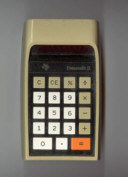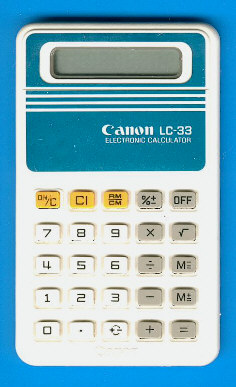
DATAMATH CALCULATOR MUSEUM
 |
DATAMATH CALCULATOR MUSEUM |
Canon LC-33
| Date of introduction: | year 1982 | Display technology: | LCD |
| New price: | Display size: | 8 | |
| Size: | 4.6" x 2.6" x 0.4" 116 x 70 x 10 mm3 |
||
| Weight: | 3.2 ounces, 91 grams | Serial No: | |
| Batteries: | 2*LR44 | Date of manufacture: | mth 05 year 1982 |
| AC-Adapter: | Origin of manufacture: | Japan | |
| Precision: | 8 | Integrated circuits: | Toshiba T6775B |
| Memories: | 1 | ||
| Program steps: | Courtesy of: | Joerg Woerner |

 This
Canon LC-33 looks different to its predecessor LC-31
and makes use of a novel manufacturing technology.
Instead of using a traditional printed circuit board
(PCB) the LC-33 uses a flexible foil pressed against a heavy metal sheet. Not
only the LC-display but even the calculator circuit missed any solder joint.
This
Canon LC-33 looks different to its predecessor LC-31
and makes use of a novel manufacturing technology.
Instead of using a traditional printed circuit board
(PCB) the LC-33 uses a flexible foil pressed against a heavy metal sheet. Not
only the LC-display but even the calculator circuit missed any solder joint.
We noticed this construction already with the LX-30
and LX-40, too. Main differences between this LC-33 and
the two LX sibblings are the 3-key versus 4-key memory and the [+/-] function.
About two years later we Canon introduced with the LC-34 a traditional design again.
Don't miss the colorful LC-33 versions featuring the PEANUTS Characters,
we know them with a white, yellow and pink
housing or the PADDINGTON BEAR in a white
housing.
![]()
If you have additions to the above article please email: joerg@datamath.org.
© Joerg Woerner, October 11, 2001. No reprints without written permission.